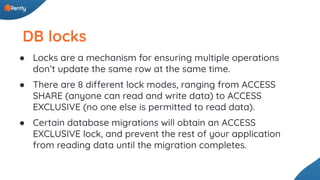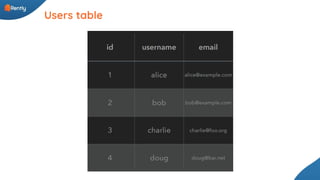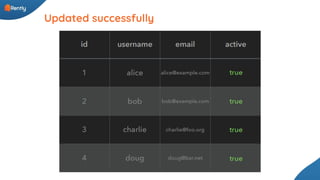Rails DB migrate SAFE.pdf
- 1. DB (safe) MIGRATIONS rails db:migrate:safeeeeeee...
- 2. Migrations ● Migration is a set of database instruction. ● They describe database changes. Rails migrations ● Rails Migration allows you to use Ruby to define changes to your database schema, making it possible to use a version control system to keep things synchronized with the actual code.
- 3. ● Adding a column ● Backfilling data ● Removing a column ● Changing the type of a column ● Renaming a column ● Renaming a table ● Creating a table with the force option ● Adding a check constraint ● Setting NOT NULL on an existing column ● Executing SQL directly Some of the unsafe migrations
- 4. ● Adding an index non-concurrently ● Adding a reference ● Adding a foreign key ● Adding a json column Postgres-specific checks
- 5. Adding a column Not really!
- 7. Locks!
- 8. DB locks ● Locks are a mechanism for ensuring multiple operations don’t update the same row at the same time. ● There are 8 different lock modes, ranging from ACCESS SHARE (anyone can read and write data) to ACCESS EXCLUSIVE (no one else is permitted to read data). ● Certain database migrations will obtain an ACCESS EXCLUSIVE lock, and prevent the rest of your application from reading data until the migration completes.
- 9. Users table
- 10. Table locked
- 11. Column added
- 13. Migrated
- 14. How can this be avoided???
- 15. DON’T add columns with a default value.
- 16. Because, ● Of the locking mode it uses and can and will cause downtime if you have enough rows in your database and enough traffic on the system. ● Though Postgres 11 actually addresses this problem in certain circumstances. Adding a static default value no longer requires obtaining a table level access exclusive locks. But note the caveat, under certain circumstances. ● For example adding backfilling a new UUID column will obtain that lock.
- 17. Adding a column (Without a default value) Now let’s try that again
- 18. Adding a column (without a default value)
- 20. Transactions!
- 21. DB transactions ● Transactions combine multiple database operations into a single, “all-or-nothing” operation. ● They provide four guarantees: atomicity, consistency, isolation, and durability (“ACID”). ● Consistency and isolation are guaranteed by locks. ● When a a row is being updated, an exclusive lock is issued, and no one else can update that same row until the first update is complete.
- 22. DB transactions ● Locks are issued on a first-come, first-served basis, and live for the duration of a transaction, even if the statement that requested the lock has already executed. ● Migrations are automatically wrapped in a transaction. ● So for most of your database operations this might not be a problem, as it usually happens in a the order of milliseconds. ● But when you have to perform millions of database operations on a very large datasets.
- 23. Updating in a transaction
- 24. Updating in a transaction
- 26. So, how this transactions affect migrations ● Our columns were added, with row 1 we are not actually locking the entire table, but instead the first row is locked, mark it true and move on. Even though it was successful, as I mentioned, that lock doesn't get released until your transaction get committed.
- 27. Adding a column (THE CORRECT WAY)
- 28. DON’T BACKFILL DATA INSIDE A TRANSACTION.
- 29. Backfilling data (THE CORRECT WAY)
- 30. disable_ddl_transaction! ● It disables that global transaction. ● It is implicitly enabled but you can explicitly when you're running a particular migration. ● So, we write a separate migration and run once the column was added. ● Rather than marking every single user inside/outside a transaction, we iterate users in batches and wrapping each individual batch inside of a transaction. ● Batch size defaults to 1000 of course it's configurable based on your individual needs.
- 31. What’s the difference?? ● This transaction that is updating 1000 rows is gonna complete and commit much faster than a transaction updating 10 million rows. ● That changes your lag time from minutes to order of seconds or even lesser where an individual subset of users might receive a slightly delayed response. ● So, users most likely won't even notice that anything happened. ● So our rule of thumb here is???
- 32. DON’T MIX SCHEMA AND DATA CHANGES.
- 33. What now?? ● We have successfully added users who are active. ● But how are we gonna look up active users? ● Any idea??
- 34. Adding an index Not really! For Postgres only
- 35. Adding an index
- 36. Indexing will ● Interfere with regular operation of a database. ● Locks the table to be indexed against writes and performs the entire index build with a single scan of the table. ● Have a severe effect if the system is a live production database. ● Very large tables can take many hours to be indexed, and even for smaller tables, an index build can lock out writers for periods that are unacceptably long for a production system.
- 37. DO ADD POSTGRES INDICES CONCURRENTLY.
- 38. Adding an index (THE CORRECT WAY)
- 39. algorithm: :concurrently ● Waits for all existing transactions that could potentially modify or use the index to terminate. ● Requires more total work than a standard index build and takes significantly longer to complete. ● Useful for adding new indexes in a production environment. ● Of course, the extra CPU and I/O load imposed by the index creation might slow other operations.
- 40. Concurrency!
- 41. L = λ * W Little’s law Concurrency Throughput Response Time 4 = 100 * 40 ms Concurrent requests Req’s / sec Response Time
- 42. Concurrency ● Every application has a theoretical maximum level of concurrency it can support at any given time. ● Your database obeys the same principles. How fast your queries are, and how large your connection pool is, determines how many queries you can concurrently handle. ● Requests start queueing when they arrive faster than your application, or its database, can respond to them. ● If a database operation blocks many requests for a long time, your entire application will grind to a halt.
- 44. DB Performance ● You don't have to understand the performance characteristics of the application. ● But you have to understand how they change during before and after your migration. ● You have to do this on a regular basis. ● If we had an understanding on the effects of the migration even before we migrate them live, makes an advantage on us to not drop on outages.
- 46. Gems ● To help your database healthy and still can add schema changes. ● Static analysis will warn in advance about certain unsafe migrations. ● Catch problems at dev time, not deploy time. ● ankane/strong_migrations ● LendingHome/zero_downtime_migrations ● Not technically a gem, but: Gitlab migration helpers
- 47. Strong migrations ● Catch unsafe migrations in development ● Detects potentially dangerous operations ● Prevents them from running by default ● Provides instructions on safer ways to do what you want ● Supports for PostgreSQL, MySQL, and MariaDB
- 48. Strong migrations - Warning and Suggestions
- 49. Strong migrations - Warning and Suggestions
- 50. Application Performance Monitoring ● Understanding your application's baseline performance is critical to understanding how migrations will change its performance characteristics.
- 51. Takeaways ● DON’T add columns with a default value. ● DON’T backfill data inside a transaction. ● DON’T mix schema and data changes in the same migration. ● DO add Postgres indexes concurrently. ● DO monitor and test database performance before, during, and after migrations.
- 52. Questions???
- 53. IF WE WRITE SAFE MIGRATIONS, WE'LL RUN SAFE MIGRATIONS. Thank you!




















































